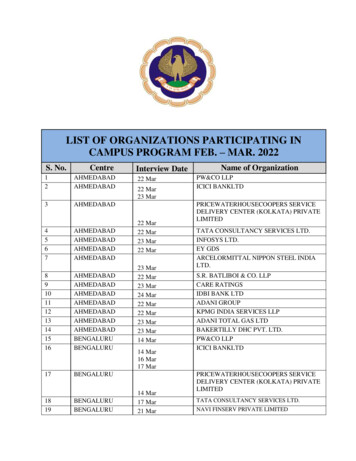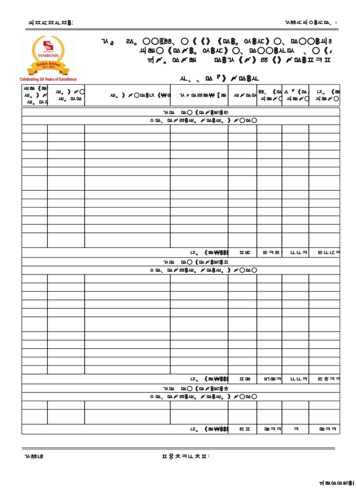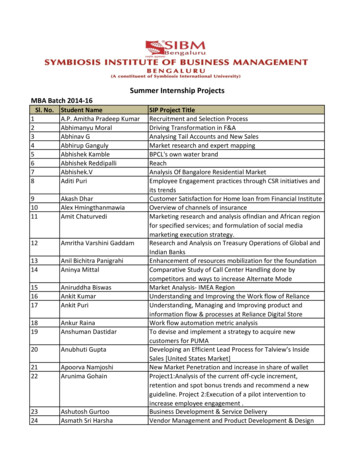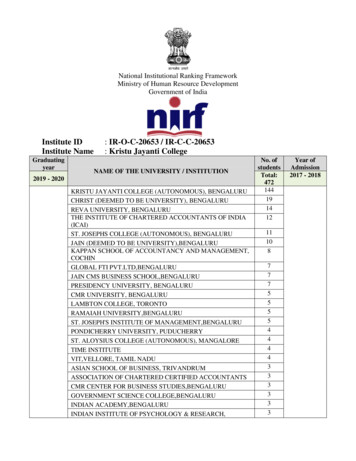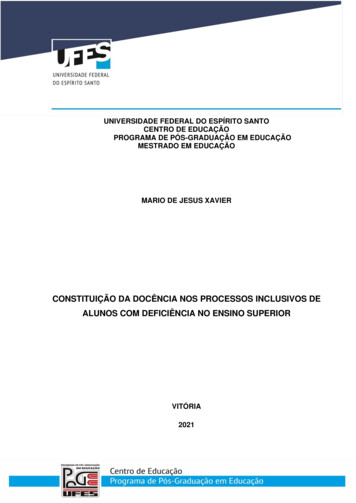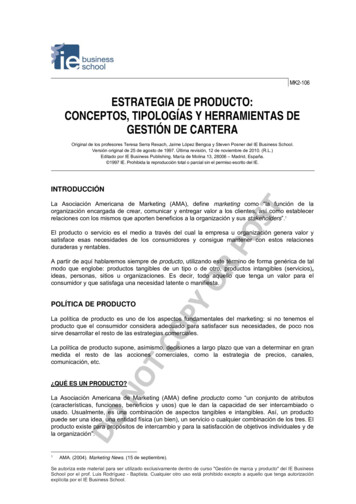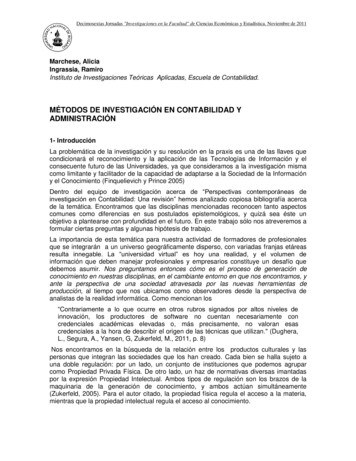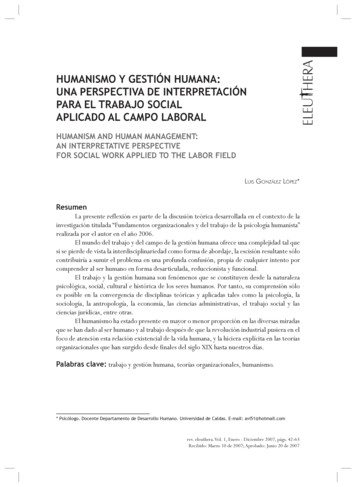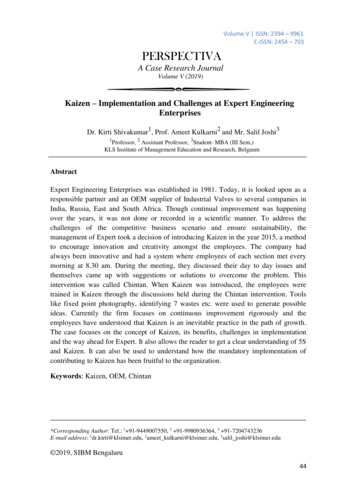
Transcription
Volume V ISSN: 2394 – 9961E-ISSN: 2454 – 703PERSPECTIVAA Case Research JournalVolume V (2019)Kaizen – Implementation and Challenges at Expert EngineeringEnterprisesDr. Kirti Shivakumar1, Prof. Ameet Kulkarni2 and Mr. Salil Joshi31Professor, 2 Assistant Professor, 3Student- MBA (III Sem,)KLS Institute of Management Education and Research, BelgaumAbstractExpert Engineering Enterprises was established in 1981. Today, it is looked upon as aresponsible partner and an OEM supplier of Industrial Valves to several companies inIndia, Russia, East and South Africa. Though continual improvement was happeningover the years, it was not done or recorded in a scientific manner. To address thechallenges of the competitive business scenario and ensure sustainability, themanagement of Expert took a decision of introducing Kaizen in the year 2015, a methodto encourage innovation and creativity amongst the employees. The company hadalways been innovative and had a system where employees of each section met everymorning at 8.30 am. During the meeting, they discussed their day to day issues andthemselves came up with suggestions or solutions to overcome the problem. Thisintervention was called Chintan. When Kaizen was introduced, the employees weretrained in Kaizen through the discussions held during the Chintan intervention. Toolslike fixed point photography, identifying 7 wastes etc. were used to generate possibleideas. Currently the firm focuses on continuous improvement rigorously and theemployees have understood that Kaizen is an inevitable practice in the path of growth.The case focuses on the concept of Kaizen, its benefits, challenges in implementationand the way ahead for Expert. It also allows the reader to get a clear understanding of 5Sand Kaizen. It can also be used to understand how the mandatory implementation ofcontributing to Kaizen has been fruitful to the organization.Keywords: Kaizen, OEM, Chintan*Corresponding Author: Tel.: 1 91-9449007550, 2 91-9980936364, 3 91-7204743236E-mail address: 1dr.kirti@klsimer.edu, 2ameet kulkarni@klsimer.edu, 3salil joshi@klsimer.edu 2019, SIBM Bengaluru44
Volume V ISSN: 2394 – 9961E-ISSN: 2454 – 7034Mr. Vinayak Lokur was intrigued. The calm, cool CEO of Expert Engineering had a subtle smileon his face, which was prompted by the interaction he had with Salil, the young managementintern. Salil was a student pursuing his MBA from a well-known B-School. He had chosen tostudy the impact and implementation of Kaizen at Expert Engineering. Earlier in the day, Mr.Lokur had an interaction with Salil and asked him how his project was going on. Salil explainedto Mr. Lokur what he was currently doing and how Mr. Kotwal, the Marketing Engineer andKaizen head was helping him. At the end of the interaction Salil asked Mr. Lokur, “Sir, Iunderstand that the company has benefitted immensely because of the implementation of Kaizen.I have myself in this short while, seen how different your company is from other companies’. Ihave observed how attention is paid to minute details in all departments, how organized thestorage is and how any tool/document can be retrieved quickly. I know that you believe thatthose organizations which nurture their employees and involve them in Quality Management canexpect their products or services to be of a high quality. At Expert, the management hasintroduced a policy of submission of one Kaizen idea per month per employee. How wasimplemented Kaizen so effectively at Expert? I would also like to understand how we canclassify an improvement as belonging to 5S category or Kaizen?”About Expert EngineeringExpert Engineering Enterprises, was established in 1981, today is looked upon as a responsiblepartner and an OEM supplier of Industrial Valves to several companies in India, Russia, East andSouth Africa. Though continual improvement was happening over the years, it was not done orrecorded in a scientific manner. To address the challenges of the competitive business scenarioand ensure sustainability, the management of Expert took a decision of introducing Kaizen in theyear 2015, a method to encourage innovation and creativity amongst the employees. Thecompany had always been innovative and had a system where employees of each section metevery morning at 8.30. During the meeting, they discussed their day to day issues andthemselves came up with suggestions or solutions to overcome the problem. This interventionwas called Chintan. The concept of Kaizen was explained and implemented through thediscussions held during the Chintan intervention. Slowly but steadily Kaizen as a practice wasaccepted, understood and appreciated. Tools like fixed point photography, identifying 7 wastesetc. were used to generate possible ideas. Currently the firm focuses on continuous improvementrigorously and the employees have understood that Kaizen is an inevitable practice in the path ofgrowth.Introduction to KaizenThe foundation of Kaizen can be traced to Japan, post-World War II. It was after the US conflictwith Korea, that Japan became a major supplier to the US Military. This helped Japan rebuild its45
Volume V ISSN: 2394 – 9961E-ISSN: 2454 – 7034industries. The US helped Japan to rebuild its industries in various ways. It was in the 1950s thatQuality Guru Edwards Deming guided Japanese managers to develop quality systems with thehelp of statistical quality control methods. The core philosophy of Kaizen is based on theDeming wheel which involves the steps of Plan, Do, Check and Act called as the PDCA cycle. Itwas the Japanese management consultant, Masaaki Imai who popularized the concept of Kaizenthrough his works “Kaizen: Japanese spirit of improvement” (1985), and Gemba Kaizen: ACommonsense, Low-Cost Approach to Management (1997). Masaaki Imai, defined Kaizen and“continuing improvement in personal life, home life, social life, and working life. When appliedto the workplace, Kaizen means continuing improvement involving everyone – managers andworkers alike."The term “kaizen”, is made up of two Japanese terms; “kai” meaning change and “zen” meaninggood, simply means “change for the better”. Literally translated it covers all steps and effortstaken to implement improvements continuously. Kaizen refers to an organization wide approachwith its foundation on common sense, voluntary discipline, and conscious effort to reducewastage and rework. It forms the essence of lean manufacturing and is applicable to everythingin the organization right from personal efforts, production processes, purchase, supply chain andeven software development. The hall mark of Kaizen is that it involves everyone right from theCEO/head of the organization to the shop floor operator as well as the security guard at the gateof the organization. Kaizen became an integral part of the “Toyota Production System”, and waslooked upon as an effective way to get the entire organization get involved in the effort toenhance production, quality and reduce wastage. Since then Toyota has been synonymous forimprovement and growth and several companies follow the “Toyota way of Life”, as it ispopularly called. The Japanese consider Kaizen as the stepping stone for growth and respect thepractice of Kaizen immensely.According to a Toyota internal document, "The Toyota Way 2001," released in April 2001, thebasic principles of the Toyota way are as follows: Kaizen has been understood as an approach which leads to continuous improvement as a resultof basic and voluntary but ongoing positive changes at the workplace. The essence of Kaizen isthe cooperation and voluntary commitment to bring about changes in small, inexpensive wayssuggested by the person who is doing a task on a daily basis. It does not refer to radical changesbut small continuous improvements. Kaizen as the core to lean manufacturing, or The ToyotaWay was practiced in the manufacturing sector to reduce defects, reduce rework and waste,enhance productivity, boost employee involvement /accountability, and stimulate innovation.46
Volume V ISSN: 2394 – 9961E-ISSN: 2454 – 7034Continuous improvement Challenge - Develop a long term vision , overcoming challenges with courage andcreativity . Kaizen - Focus on continous improvement , keep working towards innovation Genchi Genbutsu- Find out the root cause so as to understand the whole situationand then make proper well informed decisions.Respect for people Respect - Respect each other in organizsation, involve everyone , and allowindividuals to make decisions in those tasks which they do on a day to day basis ,because no one knows their job better than them. Teamwork - Encourage team work , stimulate each team member to contribute andcreate synergy .Several companies like Boeing and Caterpillar, have over the years, redesigned their plants andentire processes to adopt the Toyota Way, which have become synonymous to efficiency,reduced wastage and quality control.Tara Jones: 2017, gives several examples of how companies used have Kaizen effectively: a. At the Great Western Bank opening a checking account used to take 34 steps. With theadoption of Kaizen, the numbers of steps have been reduced to 24.b. When Ford was going through a tumultuous period in the year 2000, they focused onefficient processes based on the Kaizen principles and were able to recover.c. When the American furniture manufacturer Herman Miller adopted Kaizen, theywerebenefitted with a 500% increase in productivity and quality. Earlier it took them 82 secondsto manufacture one chair, now the similar chair is produced in 17 seconds.By following the principles of the Toyota way, organizations became more profitable, agile andquicker to respond to change. Kaizen with its focus on continuous improvement is the integralpart of the Toyota Way.In short Kaizen is not a just a onetime activity for improvement or a set of tools to improvequality. It is continuous journey to improve productivity, by reducing waste (Muda), eliminatingrework and tiresome effort, empowering employees to identify changes and improvement.Kaizen is not a one day or one-time process, but a practice where employees are involved everyday to incorporate such changes and improvement.47
Volume V ISSN: 2394 – 9961E-ISSN: 2454 – 7034Any improvement under the umbrella of kaizen would follow the PDCA cycle;Plan – Mapping the change so that everyone knows what to expect when the team wantsto implement some improvementDo- To implement the best or most feasible solution to the problemCheck – Evaluating if the solution has worked and has led to improvementAct- At this stage, the team or organization decides whether this change should beadopted as practice in the company or if further change is needed. If further changes arerequired, the kaizen cycle repeats again from the planning stage.Company profileOverviewExpert Engineering Enterprises, was established in 1981, today is looked upon as a responsiblepartner and an OEM supplier of Industrial Valves to several companies in India, Russia, East andSouth Africa. The mission of Expert Engineering is to create value and in the process pass on thederived advantage to their customers. The foundation of the mission statement rests on their twovalues, "Winning together" and "Continuous Business Excellence".48
Volume V ISSN: 2394 – 9961E-ISSN: 2454 – 7034Expert has been striving to achieve long term relationships with their customers and suppliers,based on integrity, cost and constant quality control. The main advantage that Expert has isqualified, experienced and committed people, backed up by their focus on continuousimprovement. They have developed their supply chain ensuring them reliable supply of qualitycastings and forgings which enables them to maintain competitive cost. They have beenaccredited by several national and international organizations. (ISO 9001:2008, ISO 14001:2004,OSHAS 18001:2007, EIL (Engineers India Ltd.), IBR (Indian Boiler Regulatory Authority) aswell as by Project Consultants namely Mecon, Toyo, PDIL , UHDE , DVC and Avant Garde.In the words of the CEO, “We at Expert continuously focus on Business Excellence. We strive toinnovate and improve the effectiveness of our organization, we pay utmost attention to theminute details of all our important business functions as Human Relationship Management,Vendor Management, Capacity up-gradation/automation and Quality Control Management.” Intheir quest for Business Excellence they have worked to achieve numerous certificationsincluding the prestigious API certification in 2011.ClienteleThe clients of Expert Engineering belong to sectors like Prestigious Valve Manufacturers,Original Equipment Manufacturers (OEM's), Project Organizations, Paper Industry, CementIndustry, Steel Industry, Sugar Industry, Ash Handling Equipment Manufacturers, ChemicalIndustry, Water Treatment Industry, Irrigation and water Supply Schemes, Dealers &Distributors in India and Abroad.QualityThey are very stringent about quality and have ensured that quality is imbibed right from designto manufacturing through assembly and delivery. Every Expert Valve / Component is 100%inspected before dispatching. Every step from procurement through production, welding,assembly, testing and packaging is in accordance with written rules contained in QA manuals.Each valve is pressure tested in accordance with the relevant standard or special customerrequirements as applicable. The test status is recorded product wise.Continual ImprovementToday continual improvement has become an integral aspect of everything they do. As ArifKotwal, the Kaizen Head stated “right from initiating best practice within the manufacturingenvironment, to managing the flow of data through the business, and involving employees atevery step, we have a dedicated cross functional team which is accountable for continualimprovement. Our Chintan programme is like a Quality Circle. It is the base unit for our KaizenProgramme. You can see we have implemented measures which draw from 'Lean' methodology.49
Volume V ISSN: 2394 – 9961E-ISSN: 2454 – 7034Through Kaizen practices we have been constantly eliminating waste, enhancing efficiency andconcentrating on the value addition for customers.”Vision and PhilosophyVision: “To Become a 100 Crore company by the year 2020, and attain business excellence.”Philosophy: "Winning Together"Kaizen Evolution in Expert Engineering Enterprises:Kaizen process was adopted in the system of Expert in the year 2015. From the year 2015, theimplementation of Kaizen was being carried out in the organization. The employees werevoluntarily asked to come up with kaizen ideas and then with the help of the management andother employees, the change was implemented. The results were seen immediately and there wasincrease in the productivity of the organization. All the Kaizen activities were properlydocumented in a given format and those documents are stored till date. Also, at the end of everyfinancial year, the top management awarded a “BEST KAIZEN” award to the most effectiveKaizen carried out. From then on, there were numerous Kaizen activities carried out in all thedepartments to attain continuous improvement in the organization.There have been 445 Kaizen activities carried out in the year 2015-16 and 430 Kaizen activitiesin the year 2016-17. (Please refer Exhibit II, III and IV for details) Earlier the employees werevoluntarily asked to submit the kaizen ideas, but now the company has employed a policy of oneKaizen idea compulsory for each employee every month. The staff distributes slips to theemployees working on the shop floor in which the employees can fill out their Kaizen idea inbrief and then carry out the same. Due to the compulsion, every employee submits at least onekaizen idea every month which contributes to the continuous improvement in the organization.Due to the documentation of Kaizen in the specific format, there is availability of entire datarelated to the Kaizen, which further helps in confirmation and verification of the Kaizen activityafter some time, to check whether the Kaizen is still in continuation or not.Kaizen Process in Expert Engineering EnterprisesThe Process of Kaizen mainly involves two aspects: 1) What leads to a Kaizen? 2) Actual Process of Kaizen.1) What Leads to a Kaizen? This further involves three aspects. They are as follows: -50
Volume V ISSN: 2394 – 9961E-ISSN: 2454 – 7034a) Process Problems: - This involves the problems encountered by the workers, staff ormanagement while carrying out a process. If there is any obstruction or hindrance for smoothcompletion of the process, then that leads to a Kaizen idea.b) Feedback: - This involves feedback from various people which may lead of the generation ofKaizen idea. There may be feedback from the customers, suppliers, vendors, or even internalfeedback from the employees or the management about any activity leads to a Kaizen activity.c) Management Decisions/ Programs: - The management may take a decision or develop aprogram which may lead to development of a Kaizen activity. The decision may be taken owingto a change which is desired in the organization. The above aspects lead to a Kaizen activity inthe organization.2) Actual Process of Kaizen: (see Exhibit I for flowchart)The actual process of Kaizen is as follows: i.Kaizen inputs: The first step in the kaizen process is the kaizen inputs. These are theinputs given by various people involved in the process. This is the preliminary step wherethere is recognition of the problem and need for the kaizen activity arises.ii.Problem definition: - The next step is the definition of the problem. Here what is theexact problem is clearly defined, so that it becomes clear and easy for taking furthersteps.iii.Why analysis: - The next step is the why- why analysis. In why analysis there is focus onwhy is there problem and then with the further analysis, the root cause of the problem isunderstood.iv.Root cause – After the why analysis the root cause of the problem is understood. Whyexactly has the problem arrived, and what are causes leading up to the problem?v.Kaizen planning: - After the root cause is found out, there is planning activity of thekaizen. What can be done to eliminate the problem at hand, what are the differentmethods that may be used in the kaizen activity in an effective manner? All these thingsare planned in this step.vi.Implementation: - After the kaizen planning, the next step is the implementation of theplanned kaizen. How effectively the kaizen is being implemented and how effective andhelpful is it to eliminate the problem at hand.vii.Monitoring and measurement: - Once the kaizen activity is implemented, the last step isthe monitoring of the kaizen activity. Is the activity being beneficial or not to the processand is the problem at hand being solved or not?51
Volume V ISSN: 2394 – 9961E-ISSN: 2454 – 7034Every Kaizen Idea is classified under the following heads: Quality/ Cost Reduction/ Delivery/Safety/ Morale/ Environment/ Hygiene.52
Volume V ISSN: 2394 – 9961E-ISSN: 2454 – 703453
Volume V ISSN: 2394 – 9961E-ISSN: 2454 – 703454
Volume V ISSN: 2394 – 9961E-ISSN: 2454 – 703455
Volume V ISSN: 2394 – 9961E-ISSN: 2454 – 7034Implementation of 5S in the Purchase DepartmentObjective: To clean the work desk and enable easy access of the needed items.Description of the Problem: - The work desk was cluttered, disorganized and untidy, was notcleaned since a long time. Undue wastage of time was incurred to search items like the paperpunch, calculator, scissors, etc.Difficulties Faced: Due to the cluttered and disorganized work desk, the necessary items such ascalculators, punch machine are not found easily and require searching.Implementation: Now the work place has been organized with separators following theprinciples of ‘5S’. Sort (Seiri). Seiri refers to going through all items /objects in a particularplace and removing the unnecessary things. By removing unnecessary things and arranging onlythe required things neatly, it reduces time and effort in locating an item/object. It also helps inmaximizing the use of available space effectively.Benefits: After the implementation of the 1S principle of 5S, the necessary things such ascalculator, punching machine are easily available and the work place looks clean and tidy. Thereis no time lost in searching for small but important items which are used on a day to day basisPicture Before KaizenPicture After Kaizen56
Volume V ISSN: 2394 – 9961E-ISSN: 2454 – 7034Implementation of 5S in the Production DepartmentObjective: To prepare a separate shadow box for keeping the tools used in the productiondepartment.Description of the Problem: The tools used frequently in the production department did nothave a separate board where they can be kept according to their respective sizes and tools werekept in a vague manner.Difficulties Faced: Due to this there was difficulty to quickly locate the tool required for theoperation which caused wastage of time. It would take around 10 minutes to locate the right toolrequired.Suggestions: To prepare a shadow board where the tools could be arranged according to theirrespective shapes and sizes.Implementation: By implementing the 2nd S of the 5 S principles namely “Set in order(Seiton)”, a separate shadow board has been prepared so that the tools are arranged in a propermanner and according to their shape and size.Benefits: After the implementation of Five S, the tools are now arranged properly and are foundeasily whenever required. This prevents misplacement and loss of tools and there is no wastageof time. It has made the workflow smooth and easy. Since each item has fixed locations, it iseasy to keep back the tool after to the correct location and it becomes easy to spot anymissing/lost tool.Picture Before KaizenPicture After Kaizen57
Volume V ISSN: 2394 – 9961E-ISSN: 2454 – 7034Way AheadThe discussion with Salil, instilled a sense of nostalgia in Mr. Lokur. He recalled his trips toJapan where he had observed that every individual, irrespective of his/her designation or level inthe organisation voluntarily contributed to quality improvement by making small improvementsand incorporating simple changes in the system. He remembered his discussions with ArifKotwal about quality and was glad that they both agreed that the implementation of Kaizencannot be the responsibility of any single employee, and must involve every person who is in theorganisation.Mr. Lokur explained to Salil, “You have misunderstood our practice of Kaizen. There is amandatory requirement of every employee to submit at least one Kaizen idea. But this is notviewed as a burden by any one. We do not penalize anyone who does not submit a Kaizen ideaevery month, on the other hand we encourage participation by awarding Best kaizen of themonth with a prize of Rs. 500. You may have observed from the data collected about Kaizen thateven I am a participant in the Kaizen process and have made certain improvements in my ownscope and are of work. (See Exhibit V). I have interacted with several shop floor employees. Thehave said that they feel a sense of pride when they change they have suggested and implementedhave resulted in a positive impact, maybe in quality improvement, reduced wastage, time /effortsaved, increased productivity and so on. To understand this, you must ask Mr. Arif Kotwal howwe implemented Kaizen in the first place.”Salil went to Mr. Arif and asked him to explain the process of implementation of Kaizen atExpert. “There was a practice of having brief meetings every morning at 8.30”, explained Mr.Arif. “In these meetings, the day to day issues that the section was facing was discussed. Thisintervention was called as Chintan. The concept of Kaizen and 5S, objectives and benefits wereexplained to the employees. Each employee was asked to first make one small improvement athome. They would come back and share the Kaizens they had done at home. Some hadimplemented 5 S in their kitchens, some in their storage rooms or cupboards. We convinced ouremployees that they are best ones to identify what changes or improvements can be made, sincethey are the ones who are involved in these operations on a daily basis. Gradually all employeeshave understood that the foundation of quality improvement rests on the belief that any aspect ofan organisation and its operations can be improved. And since Kaizen itself is about continuousimprovement, we know there is always further scope for improvement”58
Volume V ISSN: 2394 – 9961E-ISSN: 2454 – 7034Exhibit I - The flow chart below depicts in sequence the various steps in the Kaizen processKAIZEN INPUTSPROBLEM DEFINITIONWHY ANALYSISROOT CAUSEKAIZEN PLANNINGIMPLEMENTATIONMONITORING ANDMEASUREMENT59
Volume V ISSN: 2394 – 9961E-ISSN: 2454 – 7034Exhibit II - KAIZENS FOR THE YEAR 2015 - 2016IMPROVEMENT INTERMS OF1S2S3SCOST REDUCTIONENVIRONMENTMORALQUALITYSAFETYSETTING TIMEREDUCTIONPRODUCTIVITYTIME SAVINGTOTALNUMBER OFKAIZENS358164206561522763396KAIZENS FOR THE YEAR 2016 - 2017IMPROVEMENT INTERMS OF1S2S3S3CCOST DUCTIVITYTIME SAVINGTOTALNUMBER OFKAIZENS3415170116178391021442560
Volume V ISSN: 2394 – 9961E-ISSN: 2454 – 7034Exhibit III - Kaizen Analysis and Segregation according to each department(for the year 2016-17)TOTAL TICED UPGRADED it IV - Number of Kaizens classified according to improvement in various aspects(for the year 2016-17)IMPROVEMENTIN TERMS ETYDELIVERYNUMBER OFKAIZENS3415170116178391061
Volume V ISSN: 2394 – 9961E-ISSN: 2454 – hibit VDocumentation of KAIZENS DONE IN December 2015 and status as on December 2018Now a centralized switch board anemergency inverter backup system hasbeen made near to the security cabinwhich enables the security guards quickaccess & also power backup whencurrent goes offRV door weight ring drilling of 150mm& 200mm.Why-1) New fixture made toaccommodate more rings to drilling atthe same time.Why-2) Earlier 3 rings were used todrill on bed.Why-3) It was standard practicefollowed in shop.Now all wire harness have beenguarded by a PVC pipe which coversall wire harness & avoid chips & metalscrap from entering into wire & thuspreventing any short circuitMoralAnil IslampureMaruti GuravPracticedCost savingGanpat DesaiGanpat DesaiPracticedSafetyVinayak Lokur SirMarutiGuravPracticed62
Volume V ISSN: 2394 – 9961E-ISSN: 2454 – 7034We prepared identification labels andstick them on box. Also we write sizeson top of box so that it is very easy toidentify correct seat guide pin and stemguide pin. Also we prepare one sheetpartition and kept seat guide pin andstem guide pin of same size in one box.Hence time to search both pins isreduced.A new holder has been made in housewhich is designed such that it uses theremaining unused edges of the tipleading to full utilization & thus savesRs150 per piece & Rs 8000 for holdersaved1. We are using stud and nut whichincreases the cost2. If we can use hex. Bolt instead ofstud and nut, we can save rs.5.5 (app.)Per assembly.We are suggesting to use hex boltinstead of stud which will reduce costContract review format revisedTime savingB.M.JainB.M.JainPracticedCost savingAnjayZendeAnjayZendePracticedCost KakadeSumitKakadePracticedSeparate files made as per customerwise, so that all details should beavailble in one fileA new tool cutter consisting of twointerchangeable insert has been madein-house by which its accuracy ,efficiency & tool life is increasedProper place identified for keeping theStationary itemsTime deAnjayZendePracticed2'S'VinayakLokur SirAnjali ShahpurkarPracticedWeight reduced in GTV 250#150Body, Bonnet, Yoke, More clearances.Cost savingVinayakLokur SirShwetaDhulapPracticedInstructions provided near ced1. Consumption of soap will be verylow.2. No spillage of soap in and aroundwash basin.1. Cost of some brought items like yokesleeve, stem, seat ring, seat guide ismore.2. We didn’t calculate cost technicallybefore and hence we didn’t reduce rateswith technical support before3. We observed that for yoke sleevethere is much more difference in ourcosting and supplier’s cost4. If we reduce cost of yoke sleeveinitially, we can reduce cost by muchmore margin5. Finally supplier is convinced and heMoraleSumitKakadeSumitKakadeNotPracticedCost savingVinayakLokur SirAishwaryaAinapurePracticed63
Volume V ISSN: 2394 – 9961E-ISSN: 2454 – 7034gave revised rates for yoke sleeve1. Cleaning by hand can be hazardousfor health.2. We can use another tool than cottonfor collection of lapping waste whichcan avoid contact of hazardous lappingwaste to human being.3. We can use steel tool for collectionof lapping waste.1. We didn’t create logic so that we willget it directly from ERP.2. We can get actual purchase cost bylinking purchase order to productionBOM so that we can get total valvepurchase price easily from ERP itself.3. No need of updating1. Casting kept in such a manner thatdust accumulated in inner side ofpowder coated body.2. Dust wiping of inner side requiresmore time than the outer side3. If we keep casting in reverse manner,require time for cleaning will be less.SafetyLaxmanLoharLaxmanLoharPracticedTime savingVinayakLokur amDhamnekarPracticedClamping done at Reception tableGlass1. Labelling is done on racks to identifythe materials and also arrangement isdone properlySafetyS.S.Lokur sirAnjali ShahpurkarPracticed2'S'ShekharBhoj
The Japanese consider Kaizen as the stepping stone for growth and respect the practice of Kaizen immensely. According to a Toyota internal document, "The Toyota Way 2001," released in April 2001, the basic principles of the Toyota way are as follows: - Kaizen has been understood as an approach which leads to continuous improvement as a result
